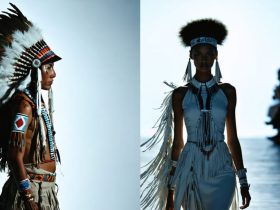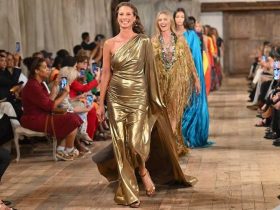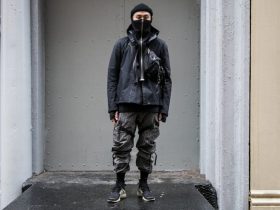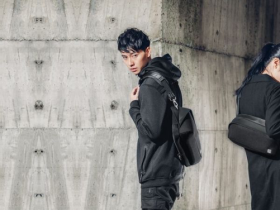in a world rich with diversity and vibrant cultures, fashion emerges not just as a means of personal expression, but as a powerful medium for cultural portrayal. From the intricate patterns of conventional textiles to the bold statements made by contemporary designers, clothing serves as a canvas on which stories, identities, and histories are painted. Yet, despite its potential, fashion often finds itself entangled in the web of stereotypes and misconceptions, limiting its role as a vehicle for inclusivity.
This article explores how fashion can transcend these barriers, celebrating the unique narratives of different cultures while breaking down the stereotypes that persist in society. Join us as we delve into the transformative power of fashion, highlighting the voices and visions that are reshaping our understanding of identity in a colorful, interconnected world.
Exploring the Impact of Fashion on Cultural Identity

Fashion serves as a canvas that reflects cultural narratives, allowing individuals to express their heritage and identity through clothing choices. It creates a dialog between tradition and modernity,providing a unique opportunity to celebrate cultural diversity. Many designers are now embracing sustainable practices and traditional craftsmanship, seeking to tell stories through their collections. This trend not only honors the roots of various cultures but also invites a broader audience to appreciate their beauty. The impact of fashion on cultural identity can be seen in various ways, including:
- Reclamation of Cultural Symbols: Many communities are reclaiming traditional garments, using them to assert their identity.
- Global Influence: Fashion trends often cross borders, fostering a blend of styles that reflects multicultural influences.
- Awareness and Education: Fashion can challenge stereotypes by educating consumers about the histories behind specific pieces.
Furthermore, collaborations between local artisans and global brands have birthed unique collections that highlight the craftsmanship of diverse cultures.Empowering communities through fashion not only preserves their cultural identity but also encourages an gratitude for artisan skills. The impact can be measured through initiatives that support fair trade and ethical fashion. For a deeper understanding, consider the following table showcasing examples of fashion brands committed to cultural representation:
| Brand | Focus | Impact |
|---|---|---|
| Alé Atelier | Indigenous Collaborations | Empowers Native artisans through fashion. |
| Patagonia | Sustainable Practices | Promotes environmental awareness while respecting local cultures. |
| H&M Conscious | Ethical Sourcing | Supports fair wages for artisans globally. |
Celebrating Diversity Through Inclusive Fashion Choices
Fashion is a vibrant tapestry woven from the threads of countless cultures,backgrounds,and identities. Embracing inclusive fashion choices allows individuals to express their unique selves while celebrating the rich diversity that exists within our global community. When brands prioritize representation,they create opportunities for people to see themselves reflected in the garments they wear. This empowers consumers to honor their heritage and personal style, whether through traditional attire or modern interpretations that incorporate cultural elements.
Inclusive fashion goes beyond just size and fit; it encompasses a wide range of factors, including color, fabric, and design influences from different cultures. Some key aspects of this movement include:
- Accessibility: Ensuring that fashion is available to all individuals, nonetheless of ability or body shape.
- Representation: Showcasing models of various ethnicities, sizes, and backgrounds on runways and campaigns.
- Collaboration: Working with diverse designers to produce collections that authentically reflect different cultures.
As the dialogue around fashion evolves, brands that embrace these principles will not only break stereotypes but also foster a sense of belonging among consumers. By prioritizing cultural representation, the industry can create a more equitable landscape that celebrates every individual’s story.
Empowering Voices: How Designers are Redefining Aesthetics
In this transformative landscape, the blending of different cultural elements fosters a sense of community and solidarity. designers are not merely creating clothing; they are igniting conversations around heritage,identity,and self-expression. Through initiatives such as community workshops and collaborations, they empower individuals to explore their own unique styles, effectively dismantling stereotypes and fostering cross-cultural dialogue. This newfound appreciation for diversity is evident in the collections that grace runways worldwide, where fashion becomes a powerful tool for advocacy and representation.
Practical Tips for Embracing Cultural Representation in Your Wardrobe
Embracing cultural representation in your wardrobe starts with an open mindset. begin by researching traditional garments and their importance,understanding the stories behind each piece. This can inspire you to integrate these elements into your daily outfits, allowing you to wear your values proudly. Consider the following practical tips to enhance your wardrobe while celebrating cultural diversity:
- Support Local Artisans: Seek out designs made by local craftspeople from different cultures. This not only helps promote their work but also fosters connections to the cultural roots of the pieces.
- Mix and Match: Combine traditional pieces with modern apparel to create unique outfits that reflect your personality and respect cultural heritage.
- choose Meaningful Accessories: Incorporate accessories that hold cultural significance, such as handcrafted jewelry or prints that tell a story.
- Educate Yourself: Learn about the cultures you wish to represent in your clothing choices to ensure you’re doing so respectfully.
When making selections, be mindful of appropriation versus appreciation. Appreciating a culture means understanding and respecting its significance while celebrating it through your fashion choices. You can create a table to highlight various cultures and their traditional garments, making it easier to understand the context behind each piece:
| Cultural Item | Culture | Significance |
|---|---|---|
| Kimono | japanese | A symbol of elegance and beauty, frequently enough worn during ceremonies. |
| Sari | Indian | Represents grace and femininity, traditionally worn at celebrations. |
| Dashiki | West African | A vibrant garment symbolizing culture and identity, frequently enough worn for special occasions. |
Wrapping Up
fashion serves as a powerful medium for breaking stereotypes and fostering cultural representation. Through clothing choices, individuals can express their unique identities while challenging preconceived notions and bias. As we continue to embrace diversity in the fashion industry, it is essential to support designers, brands, and initiatives that prioritize inclusivity and cultural authenticity. By doing so, we not only celebrate our differences but also pave the way for a richer, more vibrant fashion landscape that reflects the true essence of our global community. So, the next time you choose an outfit, remember that you’re not just making a style statement; you’re also contributing to a greater conversation about representation, acceptance, and understanding. Let’s keep pushing boundaries and redefining norms—together, we can make fashion a force for positive change.










Leave a Reply